O level physics curved mirrors or concave and convex mirrors

CURVED MIRRORS
Curved mirrors are made by cutting a part of a sphere.

Types of curved mirrors
- There are two types of curved mirrors namely: Concave mirror and convex mirror
- A convex mirror is formed when the outer surface of the part of the sphere is coated with silver.
- A concave mirror is formed when the inner surface of the part of the sphere is coated with silver.
Definitions
- Centre of curvature C: it is the centre of the sphere of which the mirror forms part.
- Radius of curvature r: it is the radius of the sphere of which the mirror forms pa
- Pole of the mirror: it is the mid-point (centre) of the mirror surface.
- Principal axis CP: it is the line that passes through the centre of curvature and the pole of the mirror
- Secondary axes: These are lines parallel to the principal axis of the mirror
- Paraxial rays: These are rays drawn close and parallel to the principal axis
- Marginal rays: These are parallel rays furthest from the principal axis of the mirror
- (i) Principal focus “F” of a concave mirror: it is a point on the principal axis where paraxial rays incident on the mirror and parallel to the principal axis converge after reflection by the mirror.
(ii). Principal focus “F” of a convex mirror: it is a point on the principal axis where paraxial rays incident on the mirror and parallel to the principal axis appear to diverge from after reflection by the mirror
- (i) Focal length “f” of a concave mirror: it is the distance from the pole of the mirror to the point where paraxial rays incident and parallel to the principal axis converge after reflection by the mirror
(ii) Focal length “f” of a convex mirror: it is the distance from the pole of the mirror to the point where paraxial rays incident and parallel to the principal axis appear to diverge from after reflection by the mirror.
- Aperture of the mirror: it is the length of the mirror surface.
Hyperbolic mirror
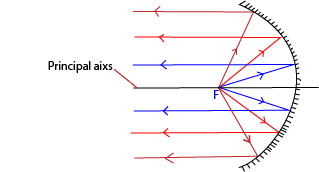
These is a type of concave mirror that reflects all the parallel incident beam on to a unique point F, the principal focus of the mirror.
Note that in car headlight and torches, the reflecting surfaces are hyperbolic. When a bulb is placed at the principal focus of reflecting surface, a strong parallel beam of light is obtained. Hyperbolic mirrors are also used in reflecting telescopes.
Geometrical rules for the construction of ray diagrams
The following is a set of rules for easy location of the images formed by spherical mirrors.
- Rays parallel to the principal axis are reflected through the principal focus.
- Rays through the principal focus are reflected parallel to the principal axis.
- Rays passing through the centre of curvature are reflected back along their own paths.
- Rays incident to the pole are reflected back, making the same angle with the principal axis.
NOTE:
(i) The normal due to reflection at the mirror surface at any point must pass through the centre of curvature.
(ii) The image position can be located by the intersection of two reflected rays initially coming from the object.
Real and virtual images
A REAL IMAGE: This is the image formed by the actual intersection of light rays from an object and can be received on the screen.
A VIRTUAL IMAGE: This is the image formed by the apparent intersection of light rays and cannot be received on the screen
Images formed by a concave mirror
The nature of the image formed by a concave mirror is either real or virtual depending on the object distance from the mirror as shown below;
Object between F and P
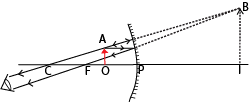
The image is
(a) formed behind the mirror
(b) Virtual
(c) Erect
(d) Magnified
This property of a concave mirror to form erect, virtual and a magnified image when the object is nearer to the mirror than its focus makes it useful as a shaving mirror and also used by dentists for teeth examination.
Object at F
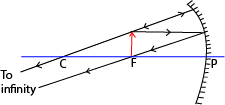
- the image is at infinity
Object between F and C
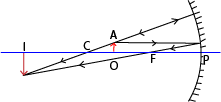
The image is
(a) Beyond C
(b) Real
(c) Inverted
(d) Magnified
Object at C
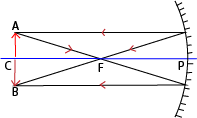
The image is
(a) At C
(b) Real
(c) Inverted
(d) Same size as the object
Object beyond C
The image is
(a) Between C and F
(b) Real
(c) Inverted
(d) Diminished
Object at infinity

the image is
1) At F
2) Real
3) Inverted
4) Diminished
NOTE;
Generally the image of an object in a concave mirror is virtual only when the object is nearer to the mirror than its focus.
Uses of concave mirrors
(i) They are used as shaving mirrors.
(ii) They are used by dentists for teeth examination.
(iii)They are used as solar concentrators in solar panels.
(iv)They are used in reflecting telescopes, a device for viewing distant objects
(v) They are used in projectors, a device for showing slides on a screen.
Image formed by a convex mirror
The image of an object in a convex mirror is erect, virtual, and diminished in size no matter where the object is situated as shown below
. 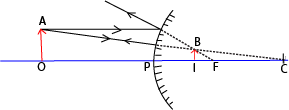
In addition to providing an erect image, convex mirrors have got a wide field of view as illustrated below.
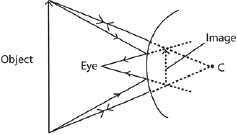
Uses of convex mirrors
(i)They are used as car driving mirrors
(ii)They are used in reflecting telescopes, a device for viewing distant objects
Construction of ray diagrams on graph paper
Step 1: On graph paper draw a central horizontal line (which acts asthe principal axis) with a perpendicular line to act as the curved mirror,
Step 2: Where distances are given, choose a scale for object size and position.
Step 3: Measure the focal length F and radius of curvature r from the mirror and mark C and F as centre of curvature and principal focus respectively.
Step 4:Draw two of the principal rays to obtain the image,
Step 5: Measure the position and size of the image using the scale.
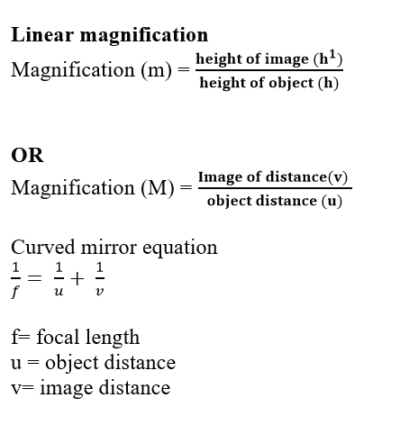
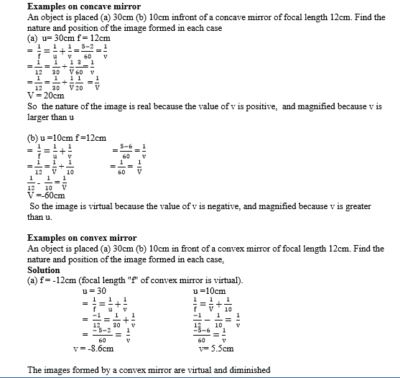
Experiments to measure the focal length of a concave mirror
Method I
A distant object is focused on the screen.
The distance between the pole of the mirror and the screen is the focal length
Method II
A sharp image of illuminated wire guaze if formed besides the wire guaze in a mirror.
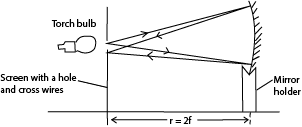
The distance between the wire guaze and the pole of the mirror is twice the focal lenght.
Use of curved mirror
(a) Shaving mirror
If the object is placed between the focal point and pole of the concave mirror, a virtual, erect and magnified image is formed. So it is used as magnifying mirror.
Diagram to be drawn

(b) Reflector
When a point source of light is placed at the principal focus of a concave mirror, the reflected beam is parallel. So concave mirrors are used as reflectors in torches and car head lamps since when the source is placed at the principal focus a parallel reflected beam is obtained. However, hyperbolic mirrors are better because the give a strong reflected beam
Diagram to be drawn
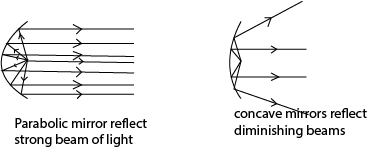
(c) Driving mirror
Convex mirrors are used as driving mirrors because they give a wider field of view than plan mirror.
Diagram to be drawn

Telescope
Both convex and concave mirrors are used in reflecting ‘telescopes because of their larger aperture as their light energy loses are smaller.
Please download pdf: curved mirrors (o-level)
Please subscribe to promote this website. Subscription is free
Share with a friend
Thank you so much

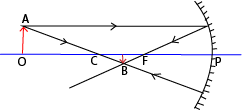
great maintain the spirit
I appreciate your teaching s
Along with every thing which appears to be building within this particular subject material, your viewpoints tend to be quite stimulating. However, I am sorry, because I can not give credence to your entire plan, all be it radical none the less. It appears to us that your commentary are actually not entirely rationalized and in fact you are yourself not really fully confident of the argument. In any case I did take pleasure in reading through it.
This is a must-read for everyone. Thanks! Toys & Games
Your blog is a breath of fresh air. Transfer Latest
Get accurate information on the MBBS Cutoff Of Private Medical Colleges in Uttar Pradesh for 2025 admissions.
Discover cutoff marks for admission at MBBS Cutoff Of Private Medical Colleges in Telangana.
Unlock special offers using the Raja Luck Invite Code.
Experience top-notch customer support and assistance on Goa Game, ensuring all your queries are promptly addressed.
Share your unique Referral Code to invite others and earn commissions through TS EARN’s program.
With a strong reputation and reliable payouts, Raja Luck is the ultimate lottery platform.
Drive long-term SEO development with Build backlinks for website.
Take pleasure in problem-free deals and additional advantages with the Goa Games Invite Code.
Find flexible and tailored Server Rental in Gurgaon services for short-term and long-lasting use.
Download the supreme gaming app today with bdg win app.
Check your abilities and technique with interesting games on 55 club.
Implement structured Technical Roadmap Planning to improve item development and IT efficiency.
THIS NOTES ARE VERY GOOD
Learn more about the **Most Costly IPL Teams**, ranking franchises based upon their market price and performance.
Every time I visit https://www.youtube.com/@kpopbuzzindo/shorts, I find something new to love about K-pop!
Exploring Varanasi was a breeze with the Varanasi City Tour itinerary.